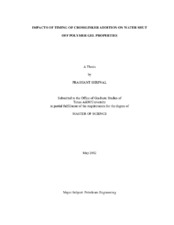| dc.description.abstract | In preparation of gelant solution for making crosslinked polymer gels for water shutoff applications unpublished experiments plus chemical intuition suggest that, unless hydrolyzed polyacrylamide (HPAM) polymer is fully hydrated before addition of crosslinker, the final gel will have lower than optimum mechanical strength. It is suggested so because polymer chains need to be unfolded before proper crosslinking can occur. We have evaluated gel strengths of “flowing” gels for water shut off in natural fractures and other non-matrix features as a function of time of addition of crosslinker relative to time of hydration of polymer. Gels were prepared from moderately high molecular weight HPAM crosslinked with chromium(III) acetate (CrAc) or polyethyleneimine (PEI). Crosslinker was added after either (1) initial wetting of solid polymer particles or (2) complete hydration of polymer.
HPAM can be purchased as a fine particulate hydrocarbon slurry or as a solution concentrate, either of which, when diluted into makeup water, rapidly provides fully hydrated polymer solution. However, dry HPAM is often preferred because of lower overall cost of active material and smaller storage footprint than slurry or liquid concentrates. The down side of using the solid product is that it generally requires two or more large blending tanks in order to fully hydrate polymer for large volume gel treatments. However, if conditions exist where crosslinker can be added to wetted but not fully hydrated polymer, then dry polymer and crosslinker can be blended in a small continuous flow unit, with full hydration occurring downhole prior to gelation.
Gel strengths were determined using a common qualitative coding system for gels prepared in identical manner except for timing of crosslinker addition. Crosslinker was added immediately after wetting of polymer or after polymer had been agitated until complete hydration. Samples were prepared in fresh water or 4% NaCl brine and at ambient temperature or 122 °F.
For almost all samples of polymer gels prepared with identical concentrations of HPAM and CrAc, there was no observable difference in gel strength regardless of time of addition of crosslinker. HPAM/CrAc polymer gels with 4wt% NaCl make up water were lower in strength by one code level with respect to those prepared with fresh water. For polymer gels hydrated at 122 °F with 4wt% NaCl there was no gel strength code level difference with respect to those prepared at ambient temperature with 4wt% NaCl.
For HPAM/PEI polymer gels the majority of the samples showed similar gel strengths regardless of the timing of crosslinker addition. A few polymer gels showed weaker gel strengths when prepared from partially hydrated polymer solution before crosslinker addition. Presence of 4wt% NaCl in the makeup water gave weaker gel strengths than those prepared with fresh water with an average difference of four code levels.
The pre-gel viscosity of a polymer solution was also compared to the timing of crosslinker addition at ambient temperature. For HPAM/PEI system the overall polymer solution viscosity decreased when PEI was added whereas for HPAM/CrAc system the polymer solution viscosity remained similar after crosslinker was added to the completely hydrated polymer solution but increased when crosslinker was added to partially hydrated polymer solution.
The most significant result of this work is the demonstration that for most field applications optimum quality gel can be obtained using dry polymer and a small continuous mixing system for initial wetting of the polymer after which the crosslinker can be added to the polymer solution on the fly. This practice can decrease the footprint, equipment requirements and labor and thus the cost of large volume flowing gel treatments. | en |


